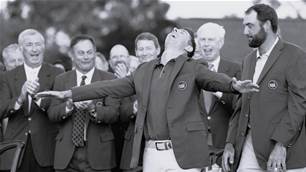Sport wouldn’t exist at all except for certain ingenious, often unrelated, little inventions that open up a world of possibilities.
Sport wouldn’t exist at all except for certain ingenious, often unrelated, little inventions that open up a world of possibilities. The inflatable bladder, the sewing machine, the lathe, the spring, the camera. The more of these inventions there are, the more sports are possible. The sport of shooting presented its own problems for practitioners until it became “modern”, when George Ligowski invented the clay pigeon and the first spring trap.
 Getty Images
Getty ImagesShooting is one of those sports we all get interested in once every few years – as we should, since we’ve produced world-beaters like Russell Mark and Michael Diamond. But in fact recreational shooting is very popular all around the country.
Back in the late 18th and early 19th centuries, when pigeon shooting first began in England, live pigeons were released from “traps” which were, in fact, top hats or boxes which covered a hole in the ground. Those who attended the traps were ordered to “pull” the trap off the birds – a term still used today.
Logistically, the sport was a nightmare. It was difficult to organise, and distance and space were problems. Then there was the matter of neighbours. As game wandered close to adjoining properties, neighbours complained either about the noise or the danger to life, limb, lamb and little children. There was the fuss of actually finding live game so one could kill it. And there was opposition from the incipient animal rights movement. This situation eventually gave rise to the search for a substitute that was just as animated, if a little less animate.
The result over the next few decades was a truly Pythonesque flying circus, with tin birds, glass balls full of feathers, rocks and other missiles taking to the skies, hurled into the air by intrepid gentlemen decked out in very impractical clothing who hoped they’d hurled it far enough to avoid being showered in lead pellets.
The problem, of course, was that none of these primitive projectiles imitated the flight of a real bird. In 1880, an American inventor from Cincinnati, Ohio, tackled the problem after watching kids skim clamshells across a lake. The sustained flight of the discs, and their gradual fall, seemed to suit his purpose – to make shooting a more practical sport – perfectly.
At first he took his own clamshell solution a little too literally, and tried to fashion a disc from the shells themselves, bonded somehow together. They proved impervious to shotgun fire ‒ unshatterable, in fact ‒ and so it was difficult to tell if a shooter actually got a hit. Eventually, Ligowski tried an amalgam of baked silt and tar. It was perfect. It could be shaped the way he wanted and was easily reproduced. Once Ligowski came up with his disc, it was a simple matter for him to invent the spring-loaded catapult that is the model for today’s more sophisticated units. These are still referred to as traps.
It all worked. Ligowski’s smashing discs instantly became a smash hit. By the turn of the century, the sport was extremely popular. With
a non-living target, all vagaries, and therefore, all excuses for missing, were eliminated and the sport became standardised. The new target was versatile and the sport transformed into a more compact and accessible one. Shooting schools and clubs developed all over America and the British Empire.
England in particular adapted Ligowski’s invention for the sport of sporting clays, where his “clay pigeons”, as they came to be known,
were able to simulate the flight of birds in real field conditions. Trap shooting came along, and the peculiarly American invention of skeet, which was designed to mimic the close and quick-shooting conditions of the New England grouse coverts.
Today, trap, skeet and sporting clays are popular international and Olympic-level sports. Trap shooting features in hugely-attended events such as the grand American Handicap in Ligowski’s home State of Ohio, and England’s sporting clays competition, the British Open and its American counterpart, the Orvis Cup.
The rest of Ligowski’s life story is obscure, but next time one of our double or single-trap or skeet shooting champions occupies the podium
at an Olympics or Commonwealth Games, spare a thought for Mr Ligowski, the man who first made shooting a martial art without malice.
‒ Robert Drane
Related Articles

Feature Story: Moving the Needle

The Aussies at The Open













